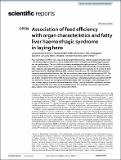| dc.contributor.author | Anene, Doreen Onyinye | |
| dc.contributor.author | Akter, Yeasmin | |
| dc.contributor.author | Groves, Peter John | |
| dc.contributor.author | Horadagoda, Neil | |
| dc.contributor.author | Liu, Sonia Yun Liu | |
| dc.contributor.author | Moss, Amy | |
| dc.contributor.author | Hutchison, Christine | |
| dc.contributor.author | O'Shea, Cormac John | |
| dc.date.accessioned | 2023-05-04T13:23:36Z | |
| dc.date.available | 2023-05-04T13:23:36Z | |
| dc.date.copyright | 2023 | |
| dc.date.issued | 2023-04-11 | |
| dc.identifier.citation | nene, D.O., Akter, Y., Groves, P.J., Horadagoda, N., Liu, S.Y., Moss, A., Hutchison, Ch., O'Shea, C.J. (2023). Association of feed efficiency with organ characteristics and fatty liver haemorrhagic syndrome in laying hens. Scientific Reports. 13, 5872 (2023). https://doi.org/10.1038/s41598-023-30007-1 | en_US |
| dc.identifier.uri | https://research.thea.ie/handle/20.500.12065/4502 | |
| dc.description.abstract | Poor feed efficiency (FE) in hens impacts body weight (BW) and may reflect suboptimal health. Fatty Liver Haemorrhagic Syndrome (FLHS) is mostly observed in laying hens and affects egg production and hen performance. The aim of this study was to investigate the relationships of FE and BW with organ characteristics, liver composition and incidence of FLHS of 150 individually housed ISA Brown hens ranked on the basis of feed conversion ratio (FCR) attained from early lay. At 45 weeks, 10 birds per FE group (HFE—High feed efficient; MFE—medium feed efficient; LFE—low feed efficient) were randomly selected and euthanized. Hen BW was positively associated with feed intake and FCR. The HFE hens had a lower abdominal fat pad and liver weight compared to LFE hens. FLHS lesion score was higher (worse) in the LFE than HFE hen group and was moderately positively associated with BW and abdominal fat pad, but strongly positively associated with liver weight. Liver pathology of LFE hens showed hepatocytes with abnormal retention of lipids causing distended cytoplasmic vacuoles compared to the HFE hens. Hens which exhibited poorer FE in early lay had heavier abdominal fat pads, heavier, fatter livers and were more prone to FLHS. | en_US |
| dc.format | PDF | en_US |
| dc.language.iso | eng | en_US |
| dc.publisher | Nature Reports | en_US |
| dc.relation.ispartof | Scientific Reports | en_US |
| dc.rights | Attribution 3.0 United States | * |
| dc.rights.uri | http://creativecommons.org/licenses/by/3.0/us/ | * |
| dc.subject | Hens | en_US |
| dc.subject | Poultry - Fatty liver | en_US |
| dc.subject | Organ characteristics | en_US |
| dc.subject | Haemorrhagic syndrome | en_US |
| dc.title | Association of feed efficiency with organ characteristics and fatty liver haemorrhagic syndrome in laying hens | en_US |
| dc.type | info:eu-repo/semantics/article | en_US |
| dc.contributor.affiliation | Technological University of the Shannon: Midlands Midwest | en_US |
| dc.contributor.sponsor | This research was funded by Australian Eggs. The Schlumberger Faculty for the Future Foundation is acknowledged for funding the doctoral studies of the first author, Doreen Anene and the Rank Prize for supporting her studies. The authors are thankful to Joy Gill, Melinda Hayter, Duwei Chen and Kylie Warr, of the Poultry Research Foundation within The University of Sydney for their additional support in carrying out this study. Greg Parkinson and Ken Bruerton are also acknowledged for the conversations and assistance on hen body weight and feed formulation, respectively. | en_US |
| dc.description.peerreview | yes | en_US |
| dc.identifier.doi | 10.1038/s41598-023-30007-1 | en_US |
| dc.identifier.eissn | 2045-2322 | |
| dc.identifier.orcid | https://orcid.org/0000-0002-1797-1941 | en_US |
| dc.identifier.volume | 13 | en_US |
| dc.rights.accessrights | info:eu-repo/semantics/openAccess | en_US |
| dc.subject.department | Department of Bioveterinary and Microbial Sciences: TUS Midlands | en_US |
| dc.type.version | info:eu-repo/semantics/publishedVersion | en_US |


